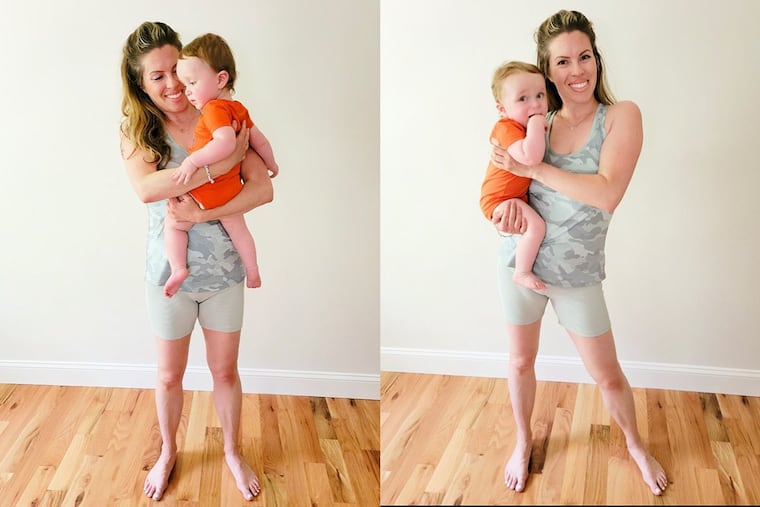How to avoid back pain while caring for your baby
When you’re busy running around with your rugrats, you’re bound to commit some common pain-provoking practices that will harm your body over time. Here are some easy fixes.

Are you having a hard time keeping up with your toddler? While toddlers are small in stature, they’re shockingly strong and become increasingly hard to hold as they put on a few more pounds each month.
So if you have faulty form when lifting your little one from crib or car seat, or are stooped down as they wobble their way to walking, you’ll soon be the one crying like a baby from parenting pains.
For the final week of Mom Month, the fitness focus is proper form during daily activities. When you’re busy running around with your rugrats, you’re bound to commit some common pain-provoking practices that will harm your body over time.
Here are the top hazardous moments in a parent’s day, and easy fixes for these postural errors:
The crib crouch
Rise and grind! Your feet haven’t even hit the floor yet and it’s already time to leap into mom mode. One of your first stops on the pain train is your baby’s bedroom, where everything sits at hip-height, which is not ideal for those with lower-back problems. Before your body has a chance to warm up, you’re crouching over a crib to lift your child, twisting your torso to lower your baby onto an awkwardly angled changing table, and then spiraling your spine to swoop your little one back up. You’ve been out of bed for only 10 minutes, and your back hurts.
Take a load off your lower back by learning the safe way to lift and transport your baby:
Step One: Always bend at your knees. It’s tempting to lean over the crib by collapsing forward at your hips with straight legs. In fact, it’s difficult not to do this based on the design of the crib. But this stance places dangerous pressure on your lower back, which can result in muscle strains and spasms. Try your best to let your legs do the heavy lifting, not your back.
Step Two: When picking up, hold your baby close to your chest. Carrying any heavy weight away from your body will cause your lower back muscles to tense and tighten.
Step Three: Rather than twist your torso to lower your baby to the changing table, shift your footing, instead. Turn your entire body in the direction in which you are lowering your baby to avoid stressing your spine.
You would never perform a strength training routine without a solid warm-up, and toting your baby around is no different. Before picking up your child, you must loosen up sensitive spots such as the lower back, hips, shoulders, and neck. Here is a one-minute stretch sequence that can be done first thing in the morning from your bed:
» READ MORE: A postpartum fitness routine that has nothing to do with weight loss
Child’s pose
Start in a tabletop position with your shoulders over your hands and knees wider than hip-width apart.
Hinge back at your hips and lower your glutes to your heels. Hold for 10 counts.
Cat cow
Return to a tabletop position. Take a deep breath in as you arch your back, feeling each vertebrae in your spine open. Pull your chin in toward your chest and tuck your tailbone under. Hold for two counts.
Exhale fully, allowing your spine to drop into a “U” shape while your gaze and tailbone shift up to the ceiling. Hold for two counts.
Repeat this child’s pose/cat cow cycle three times.
The walking aide
Helping your toddler take those first steps is exciting. To ensure that this remains a pleasant experience for parents, consider purchasing a sports scooter — essentially a low platform on four wheels — to help you sit at your baby’s level and safely roll alongside your child rather than hunching over from a standing position.
When using this must-have piece of equipment, keep your shoulders back, core engaged, and neck relaxed. Try to position your baby between your knees to prevent the urge to hunch forward.
» READ MORE: Safe, effective exercises to power you through pregnancy
The hip hugger
Until your baby is mobile and more independent, the favorite hangout spot will be on your hip. And as your child increases in size, your posture will shift to compensate. Most parents will push their baby-hauling hip out to the side, which will kick off a domino effect of misalignments throughout the body.
One simple way to safeguard your system is by checking your posture whenever possible. And if you forget, your body will remind you by communicating with aches.
Step One: Your ears should be stacked over your collarbone, and chin over chest.
Step Two: Shoulders back, rather than rounded forward, and aligned over your hips.
Step Three: Tuck your tailbone beneath your hips to help keep your core muscles engaged.
Always make time for self-care. When you’re healthy and strong, your body can support you being the best parent you can be.
Ashley Blake Greenblatt is a certified personal trainer and wellness coach in South Jersey. To learn more about her virtual training program, go to ashleyblakefitness.com.